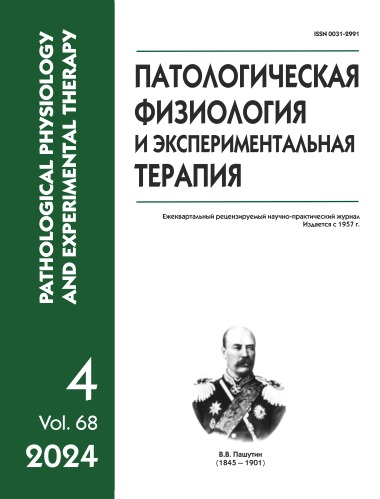Experimental evaluation of the effectiveness of respiratory support for the correction of toxic pulmonary edema
Abstract
Background. Pharmacological support and respiratory therapy are considered as approaches to the treatment of toxic pulmonary edema induced by inhalation intoxication of pulmonary toxicants. In severe intoxication, pharmacological tactics are ineffective. Information about the effectiveness of respiratory support for the correction of toxic pulmonary edema is limited in the available literature. Aim. Experimental evaluation of the effectiveness of the mechanical ventilation with maintained positive end-expiratory pressure (PEEP) for the correction of toxic pulmonary edema in rabbits caused by severe intoxication with thermal degradation products of fluoroplast-4.
Methods. Rabbits were exposed to inhalation intoxication with thermal degradation products of fluoroplast-4 (2HLC50). The rabbits underwent mechanical ventilation or mechanical ventilation with maintained PEEP. The survival rate, mean life expectancy, arterial blood gas composition and saturation were evaluated, and chest computed tomography and X-rays of the chest organs were performed.
Results. The exposure to thermal degradation products of fluoroplast-4 at a concentration of 2HLC50 (toxicity index of pyrolysis products) resulted in extremely severe intoxication of rabbits. In this process, the toxicity of thermal degradation products was due to their pulmonotoxic component, perfluoroisobutylene. Mechanical ventilation did not prevent the development of toxic pulmonary edema. At the same time, mechanical ventilation with PEEP provided an increase in the survival rate and a significant (p=0.024) increase in mean life expectancy compared with animals that did not receive treatment. In rabbits that did not receive treatment and rabbits that received only mechanical ventilation, signs of the alveolar phase of toxic pulmonary edema and pronounced arterial hypoxemia and hypercapnia were detected already in five hours after the exposure. In contrast, rabbits treated with mechanical ventilation with PEEP showed only signs of the interstitial phase of edema without a pronounced impairment of oxygenation. On the 7th day after the exposure, there were no disorders of the respiratory system structure and function in the survived rabbits treated with mechanical ventilation with PEEP.
Conclusion. The use of mechanical ventilation with PEEP is effective for the correction of toxic pulmonary edema in rabbits induced by extremely severe intoxication with thermal degradation products of fluoroplast-4 containing perfluoroisobutylene, and the protective effect is due specifically to the creation of positive end-expiratory pressure.
Downloads
References
2. Basharin V.A., Chepur S.V., Shchegolev A.V., Kharitonov M.A.,Tolkach P.G., Yudin M.A. et al. The role and place of respiratory support in treatment regimens for acute pulmonary edema caused by inhalation exposure to toxic substances. Military Medical Journal. 2019;340(11):26-32. (in Russian)
3. Trishkin D.V., Chepur S.V., Tolkach P.G., Basharin V.A., Chubar O.V., Gogolevskiy A.S. et al. Pulmonotoxicyty of synthetic polymers combustion products. Siberian scientific medical journal. 2018; 38(4): 114-20. (in Russian)
4. Yaroshetskiy A.I., Gritsan A.I., Avdeev S.N., Vlasenko A.V., Eremenko A.A., Zabolotskikh I.B. et al. Diagnostics and intensive therapy of acute respiratory distress syndrome. Russian journal of anaesthesiology and reanimatology. 2020; 2: 5-39. (in Russian)
5. Patocka J. Perfluoroisobutene: poisonous choking gas. Mil. Med. Sci. Lett. 2019; 88(3): 98-105.
6. Chepur S.V., Chubar O.V., Khalimov Yu.Sh., Akimov A.G., Khrapov K.N., Yudin M.A. et al. Guidelines for the treatment of respiratory failure in patients affected by toxic and highly toxic substances at the stages of medical evacuation. GNIII VM MO RF. – SPb.: 2016. 55 p. (In Russian)
7. Zhang Y.L., Fan L., Xi R., Zhonghua M., Dan S., Ding D. et al.. Lethal concentration of perfluoroisobutylene induced acute lung injury in mice mediated via cytokins storm, oxidative stress and apoptosis. Inhal. Toxicol. 2017; 29(6): 255–65.
8. Holmes W.W., Keyser B.M., Paradiso D.C., Radharaman R., Devon K.A., Betty J.B. et al. Conceptual approaches for treatment of phosgene inhalation-induced lung injury. Toxicol. Lett. 2016; 244: 8-20.
9. Tolkach P.G., Basharin V.A., Chepur S.V., Potapov P.K., Sizova D.T., Dimitriev Yu.V. Evaluation of the effectiveness of sedative medicals for the correction of toxic pulmonary edema during intoxication products of pyrolysis of fluoroplast-4. Uspekhi sovremennoi biologii. 2021; 141(1): 32-39.
10. Zavirsky A.V., Zatsepin V.V., Basharin V.A., Tolkach P.G., Meshkov S.A. Experimental model of combined radiation-chemical injury after exposure of x-ray radiation and intoxication by carbon monoxide. Medline.ru. Rossijskij biomedicinskij zhurnal. 2020; 21: 11-22.
11. Moroz V.V., Golubev A.M. Classification of Acute Respiratory Distress Syndrome. General Reanimatology. 2007;3(6):7-9. (in Russian)
12. Zverev M.I., Anestiadi M.Ya. Toxic pulmonary edema. main ed. M.V. Bochkaryov. Kishinyov.: «SHtiinca». 1981. 108 с.
13. Mistry S., Scott T.E., Jugg B.J., Rosi P., Sina S., Declan G.B. An in-silico porcine model of phosgene-induced lung injury predicts clinically relevant benefits from application of continuous positive airway pressure up to 8 h post exposure. Toxicol Lett. 2024; 391: 45-54.
14. Graham S., Fairhall S., Rutter S., Philippa A., Rachel R., Adam S. et al. Continuous positive airway pressure: an early intervention to prevent phosgene-induced acute lung injury. Toxicol. Lett. 2018; 293: 120-6.






